1 Introduction
Ferroelectric materials are a kind of special dielectric materials, and there is spontaneous polarization that can be reversed with the electric field. On the microscopic level, ferroelectric domain structures (microdomains with the same direction of spontaneous polarization) are usually formed. The structural origin of ferroelectricity originates from a non-centrally symmetric polar point group, and its appearance is always accompanied by a ferroelectric phase transition that changes from a centrally-symmetrical space group to a non-central-symmetrical polar subgroup. The strong nonlinearity between the polarization or electric displacement and electric field strength - the hysteresis loop. Normal ferroelectrics have a typical single electrical hysteresis loop, reflecting the field-induced polarization reversal. In the antiferroelectric body, due to the antiparallel arrangement of the dipoles on the adjacent ion lines, the macroscopic polarization is zero, and the field-induced antiferroelectric to ferroelectric state transition occurs under the action of the electric field, and the double- Hysteresis loop. The double hysteresis loop also exists in a very narrow temperature range above the Curie temperature of the first-order ferroelectric phase transition. At this time, the ferroelectric phase is the metastable phase, and the field-induced transition from the paraelectric phase to the ferroelectric phase is the cause of the double hysteresis loop. In addition, a "pinched" PE hysteresis loop is often observed. The main characteristic of this kind of elastic waist hysteresis loop is that its residual polarization (Pr) at zero field is a finite small value, which is different from the ferroelectric body (larger Pr) and antiferroelectric body (Pr is zero). .
2. How to ask why?
Jaw hysteresis loops are usually observed in lead-based and yttrium-based perovskite ceramics (Pb(Zr,Ti)O3, (Bi,Na)TiO3, etc.), but their structural root cause remains unclear. In view of the microstructural characteristics of the above two types of ferroelectric ceramics, people tend to naturally attribute them to domain wall pinning caused by defects. Although for the above ferroelectric materials, this view is self-consistent, the experimental results can often be well explained. However, there is still a lack of sufficient micro-structural evidence, and it is impossible to explain the waist hysteresis loop of non-defective ferroelectric materials. So, is the slack electrical hysteresis loop a special case of perovskite-based ferroelectric ceramics or a more common physical phenomenon in ferroelectrics? Is there a more intrinsic structural root in the elasticity of the waist hysteresis loop?
The latest results of the first-principles calculation show that there is an intermediate modulation phase with a non-uniform polarization structure in the defect-free BiFeO3 based ferroelectric material, which makes the ferroelectric sequence coexist with the antiferroelectric sequence, which leads to the electrical hysteresis of the waist. Line [1]. This discovery has undoubtedly provided new ideas for exploring the intrinsic origin of the elastic strand of the waist.
Tungsten ferroelectric ferrite strand hysteresis loop and field induced phase transition
The team of Zhejiang University Chen Xiangming/Zhu Xiaoli teamed with Fu Maosen's research group of Northwestern Polytechnical University and the S. Kamba research group of the Czech Institute of Physics in his latest work published in NPG Asia Materials [2] and found a full-filled tungsten bronze titanate The slender hysteresis loop shows clearly its structural roots from the perspective of field-induced phase transitions.
Tungsten bronze oxides are the second largest family of ferroelectric materials next to perovskites. As shown in Fig. 1, each unit cell of the tungsten bronze crystal is formed by a network of ten oxygen octahedral apexes. The network structure consists of four 15-coordinate pentagonal voids (A2) and two 12-coordinated tetragonal voids ( A1) and four triangular voids (C) whose chemical formula can be written as [(A1)2(A2)4C4][(B1)2(B2)8]O30. Tungsten bronze oxides can be classified as fully-filled (full-filled with A, B, C bits), full-filled (full-filled with A, B bits, and C-filled) and unfilled (A-bits) depending on the filling of voids. Partially full, B full, C vacant three categories. The fullest and unfilled types of tungsten bronze are most thoroughly studied, and their dielectric properties are also clearly understood. The former is generally a normal ferroelectric body, and has important applications as a nonlinear optical material; the latter is generally a dispersion or relaxation ferroelectric body, and is regarded as a nonlinear optical material and a piezoelectric material. In recent years, studies on full-filled tungsten bronze tantalum niobate M6-pRpTi2+pNb8-pO30 (M=Ba or Sr; R=rare earth;p=1,2) have shown that with the reduction of the A-site ion radius Small, its dielectric properties are transformed from the normal ferroelectric body through the dispersed ferroelectric body to a relaxed ferroelectric body [3].
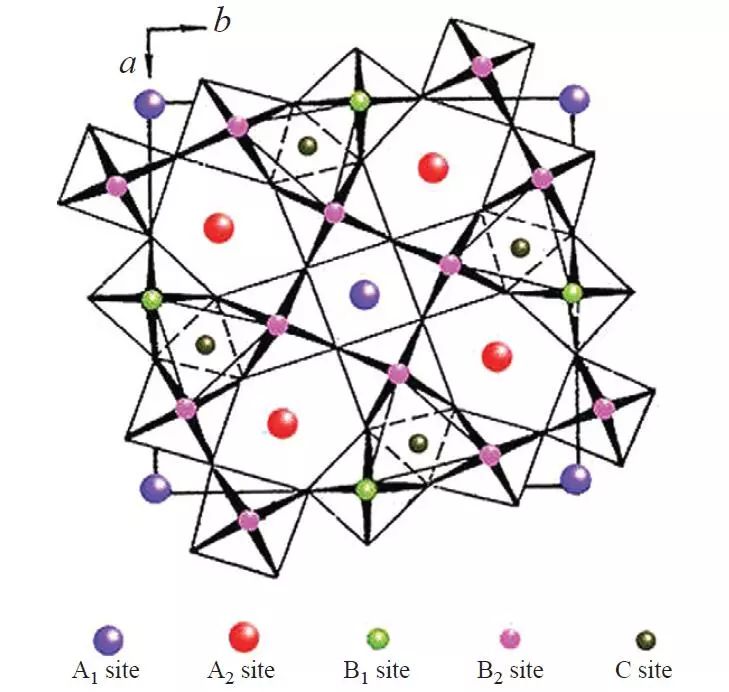
Figure 1. Schematic representation of the tungsten bronze structure as viewed along the <001> direction, where several types of polyhedrons are adaptively combined.
The Ba4R2Ti4Nb6O30 (R = Nd, Sm, Eu) ceramics all exhibited the normal first-order ferroelectric phase transition characteristics: a sharp dielectric anomaly peak and thermal hysteresis (see Figure 2), and the above-mentioned ferroelectric phase transition pattern of filled tungsten bronze The results of the study agree. However, the specific electrical hysteresis loop shown in Figure 3 has brought heavy fog. Below the ferroelectric phase transition temperature, Ba4Nd2Ti4Nb6O30 has a typical single electrical hysteresis loop, while Ba4Sm2Ti4Nb6O30 and Ba4Eu2Ti4Nb6O30 show a distinct beam waist hysteresis loop. As the temperature decreases further, the waist of the hysteresis loop gradually opens and evolves to a single hysteresis loop. The loop hysteresis loops in Ba4Sm2Ti4Nb6O30 and Ba4Eu2Ti4Nb6O30 appear below the ferroelectric phase transition temperature rather than above the ferroelectric phase transition temperature, and thus can eliminate the double field caused by the field induced phase transition of the paraelectric phase in the first-order ferroelectric phase transition. Hysteresis loop. Then, the most likely possibility is the defect pinning effect or anti-ferroelectrics. However, oxygen atmosphere and nitrogen atmosphere treatment have no significant effect on the waist stagnation loop, so the defect pinning mechanism can be preliminarily eliminated. In addition, the double electrical hysteresis loop caused by defect pinning should have a thermal activation feature, where the electrical hysteresis loop harness waist can open smoothly at low temperatures, which further eliminates the defect pinning mechanism.
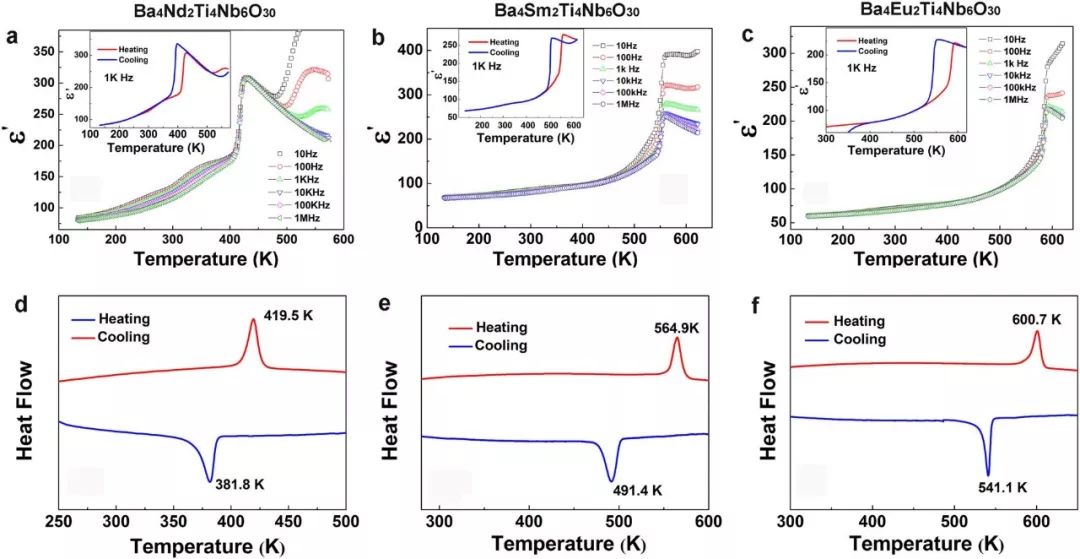
Figure 2. Primary ferroelectric phase transitions of Ba4R2Ti4Nb6O30 (R = Nd,Sm,Eu) ceramics. Ac: change in dielectric constant with temperature. The inset is the ε′-T curve measured at a temperature-raising and cooling cycle at 1 kHz. Df: DSC curve measured by the temperature cycling.
So, are Ba4Sm2Ti4Nb6O30 and Ba4Eu2Ti4Nb6O30 antiferroelectrics? If so, this is an important discovery of lead-free antiferroelectric materials other than perovskites! This is inevitably daunting... But the story is far from simple.
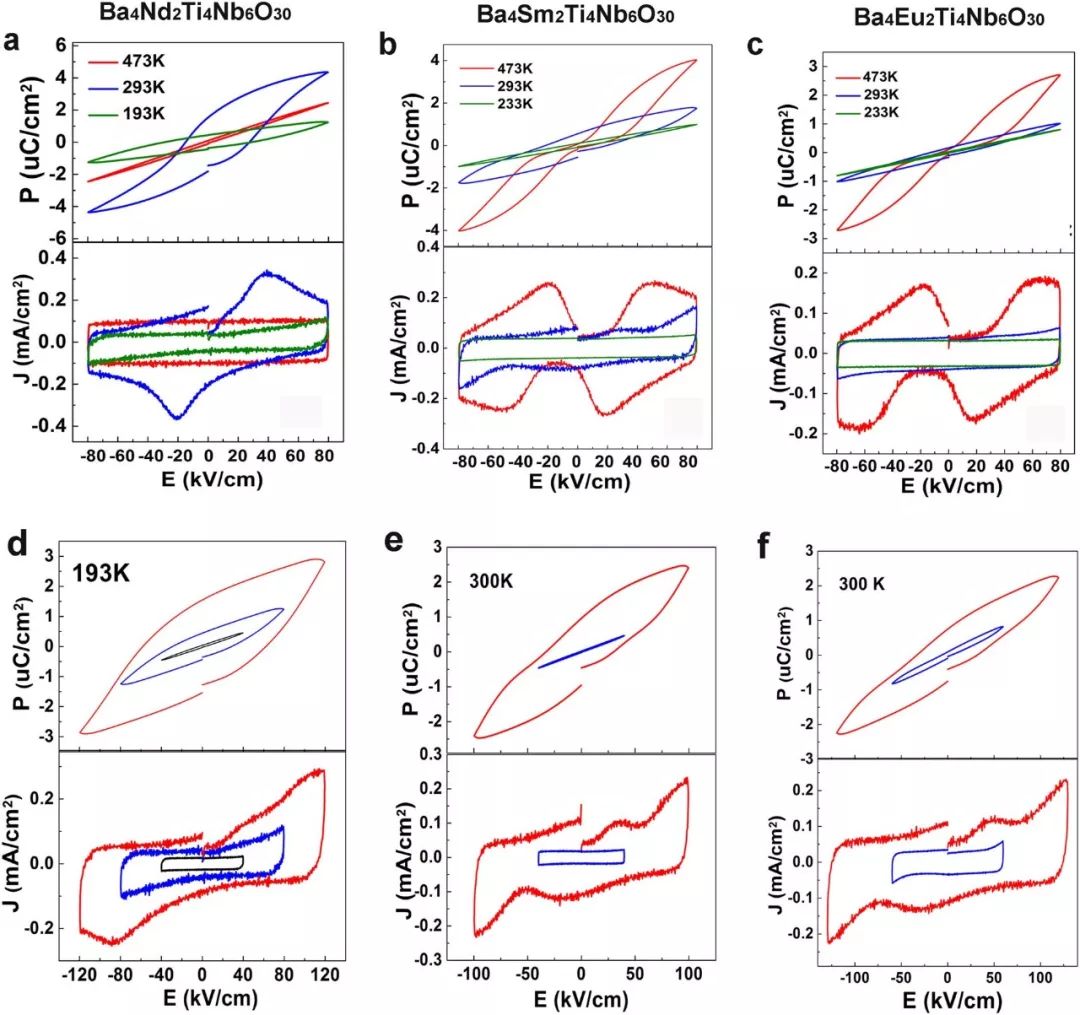
Figure 3. Polarization response of Ba4R2Ti4Nb6O30 (R = Nd, Sm, Eu) ceramic external electric field.
Based on the X-ray diffraction results of the tetragonal Tungsten bronze oxides and Rietveld structure refinement, it is impossible to distinguish between center-symmetric P4bm and non-center-symmetric P4/mbm space groups. The domain structure under the pressure microscope shown in Figure 4 reveals the true features of ferroelectric domains. The three materials all exhibit stripe-like ferroelectric domains, reflecting the typical 180° domain wall characteristics of tungsten bronze ferroelectrics. Since the antiferromagnetic domains do not have a piezoelectric response, the ferroelectric properties of Ba4R2Ti4Nb6O30 (R = Nd, Sm, Eu) ceramics can be confirmed. It is only that the ferroelectric domain in Ba4Nd2Ti4Nb6O30 is very complete and the size distribution is uniform, while the ferroelectric domain stripe widths in Ba4Sm2Ti4Nb6O30 and Ba4Eu2Ti4Nb6O30 range from 20 nm to several hundred nanometers, and there are regions where the ferroelectric domains are fragmented. In addition, the temperature-dependent SHG test results shown in FIG. 5 also indicate that the three materials have a polar crystal structure below the phase transition temperature, corresponding to a non-centrosymmetric ferroelectric phase. At this point, the possibility of anti-ferroelectric phase has also been ruled out. Although this conclusion is unwilling, it is also relieved.
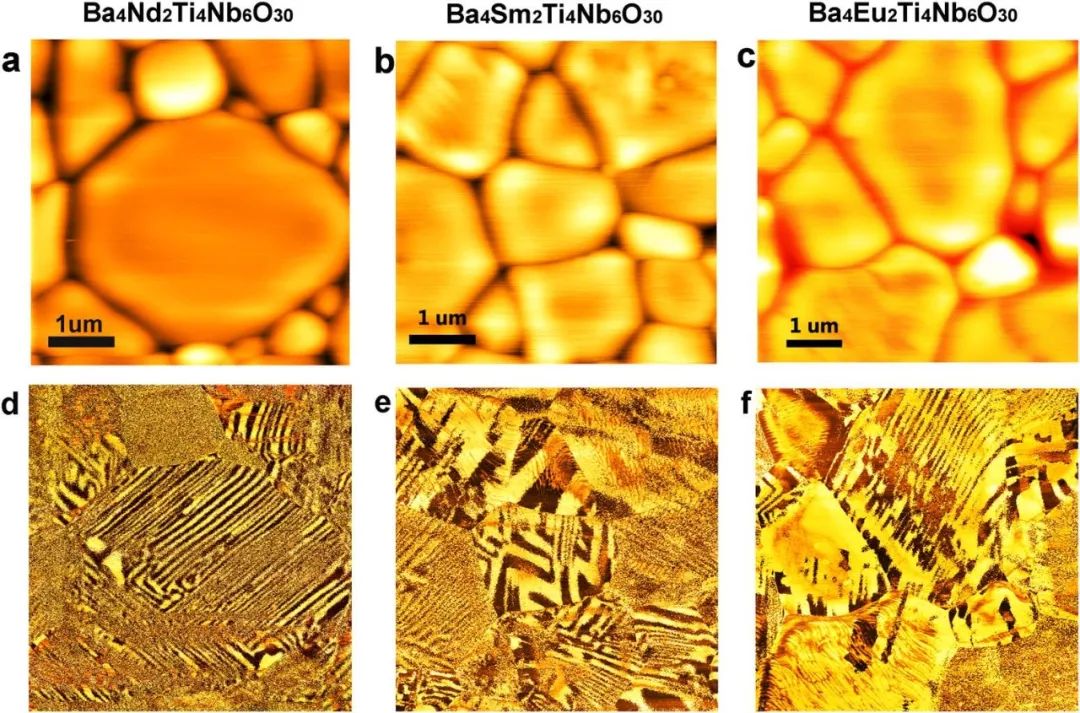
Figure 4. Surface morphology of ac: Ba4R2Ti4Nb6O30 (R = Nd, Sm, Eu) ceramics. Df: Electrostatic domain structure under a pressure microscope.
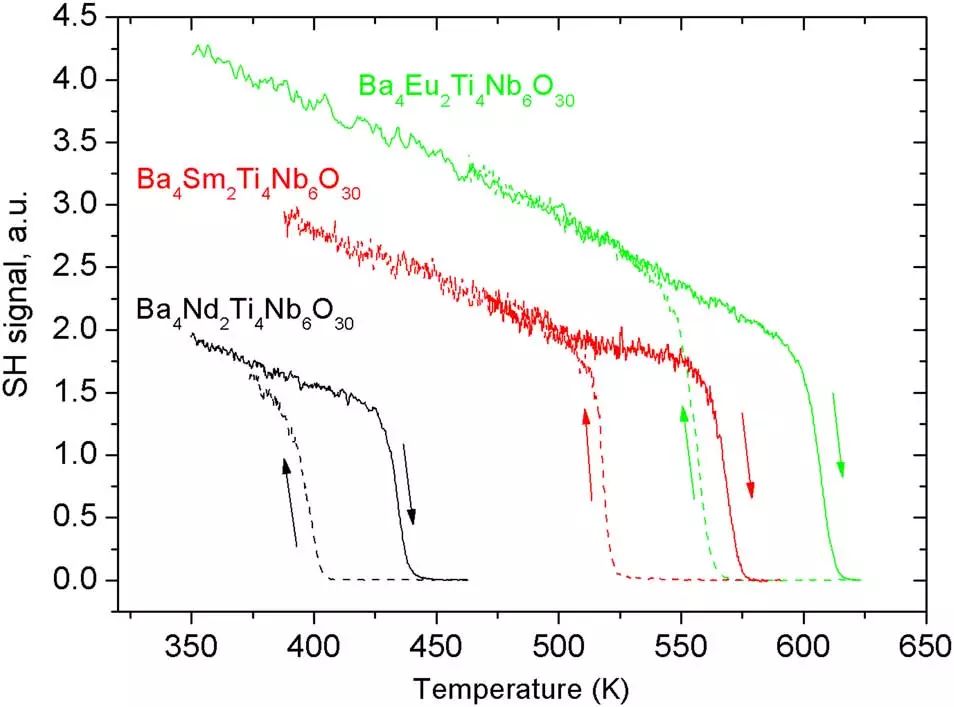
Figure 5. Second harmonic (SHG) effect during temperature rise and fall of Ba4R2Ti4Nb6O30 (R = Nd, Sm, Eu) ceramics.
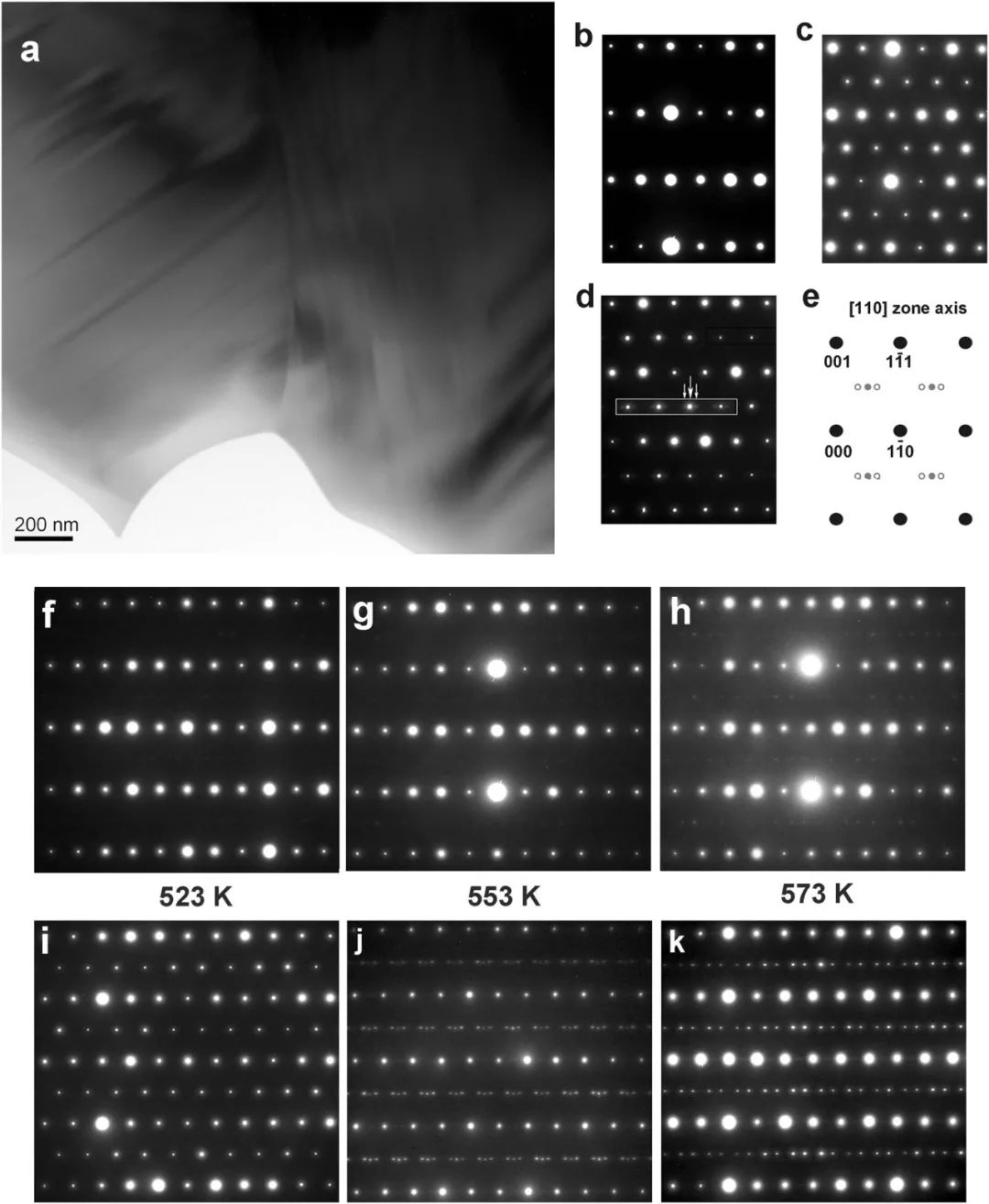
Figure 6. TEM images of Ba4Sm2Ti4Nb6O30 ceramics and selected area electron diffraction (SAED) patterns. a: 180° ferroelectric domains at room temperature. Bd: Three SAED patterns along the tetragonal tungsten bronze [110] ribbon axis. b: basic tetragonal tungsten bronze structure; c: common phase; d: indefinite phase; e: sketch of diffraction pattern. Fh and ik are the changes in diffraction patterns b and c during the ferroelectric phase transition, respectively.
At this point, the fog is gradually opening. What is the truth? Transmission electron microscopy analysis (Fig. 6) shows that in the ferroelectric phase transitions of Ba4Sm2Ti4Nb6O30 and Ba4Eu2Ti4Nb6O30, the polarity of the common phase and the non-polar indiffusion phase coexist, and this coexistence phenomenon continues until the phase transition temperature, corresponding to The temperature range in which the waist hysteresis loop exists. The non-polar involuntary phase changes to the common degree of polarity under the applied electric field, and constitutes the intrinsic origin of the elastic strand of the waist. When the temperature is lower, the involuntary phase gradually disappears, and the elastic strand of the waist is also opened.
The only remaining question now is why the same family of Ba4Nd2Ti4Nb6O30 does not show such a slack hysteresis loop. In the tungsten bronze oxide, there is usually a modulation structure caused by the octahedron tilt. As the temperature decreases, the high-temperature incommensurate modulation structure tends to change to a common modulation structure while the ferroelectric phase transition occurs. A transition temperature does not necessarily coincide with the ferroelectric phase transition temperature, which is the reason why the above-mentioned Curie temperature coexistence of common and incommensurate structures. The structural stability of Tungsten Bronze crystals decreases as the average radius of the A-site ions decreases, and this requires an incommensurate structural modulation to compensate. Therefore, in this work, the incommensurate modulation structures of Ba4Sm2Ti4Nb6O30 and Ba4Eu2Ti4Nb6O30 with small rare-earth ion radii are more stable, and coexistence of common and unprincipled modulation structures below the Curie point occurs. Eventually, the field-induced phase transition leads to electrical hysteresis in the waist. Line; and the inhomogeneous modulation structure of Ba4Nd2Ti4Nb6O30 with a larger radius of rare earth ions is more likely to change to a common modulation structure. This transformation is almost completed at the same time as the ferroelectric phase transition. Therefore, the beam waist hysteresis loop does not appear.
In summary, for the ferroelectric “because of the waistâ€, the authors experienced excitement, loss, confusion and relief, and finally unveiled heavy fog and revealed the intrinsic characteristics of tungsten bronze ferroelectric beam waist hysteresis loop. Origin - Field induced phase transition. And this, is it not the origin and true interest of learning?
The sound quality of small speakers is also good. It does not have the same large speakers and power as HIFI speakers, and its sound quality cannot compete with large speakers due to physical limitations. But for the vast majority of users who are not golden ears, the use of small speakers with tablets and mobile phones is sufficient to meet their hearing needs.
For Bluetooth retro speakers, I personally think that when many people buy speakers, the appearance is the first priority and the function is second.
We focus on retro Bluetooth speakers,It has high energy density, mini size, light weight and diversified shapes;Excellent fast charging performance, support fast charging and other excellent features
with a brand-new design, showing retro nostalgia without losing fashion. It uses a 2.5-inch speaker and has many functions such as FM radio, Bluetooth fast connection, multi-mode switching, and HIFI high fidelity. Wireless Bluetooth 4-10 hours of playback (at 50% volume), which adds to its unique charm.
Retro Speaker,Bluetooth Retro Speaker,Rechargeable Retro Speaker,Portable Retro Speaker
Shenzhen Focras Technology Co.,Ltd , https://www.focrass.com